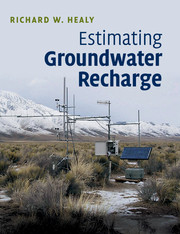Book contents
- Frontmatter
- Contents
- Preface
- Acknowledgments
- 1 Groundwater recharge
- 2 Water-budget methods
- 3 Modeling methods
- 4 Methods based on surface-water data
- 5 Physical methods: unsaturated zone
- 6 Physical methods: saturated zone
- 7 Chemical tracer methods
- 8 Heat tracer methods
- 9 Linking estimation methods to conceptual models of groundwater recharge
- References
- Index
2 - Water-budget methods
Published online by Cambridge University Press: 05 April 2013
- Frontmatter
- Contents
- Preface
- Acknowledgments
- 1 Groundwater recharge
- 2 Water-budget methods
- 3 Modeling methods
- 4 Methods based on surface-water data
- 5 Physical methods: unsaturated zone
- 6 Physical methods: saturated zone
- 7 Chemical tracer methods
- 8 Heat tracer methods
- 9 Linking estimation methods to conceptual models of groundwater recharge
- References
- Index
Summary
Introduction
A water budget is an accounting of water movement into and out of, and storage change within, some control volume. Universal and adaptable are adjectives that reflect key features of water-budget methods for estimating recharge. The universal concept of mass conservation of water implies that water-budget methods are applicable over any space and time scales (Healy et al., 2007). The water budget of a soil column in a laboratory can be studied at scales of millimeters and seconds. A water-budget equation is also an integral component of atmospheric general circulation models used to predict global climates over periods of decades or more. Water-budget equations can be easily customized by adding or removing terms to accurately portray the peculiarities of any hydrologic system. The equations are generally not bound by assumptions on mechanisms by which water moves into, through, and out of the control volume of interest. So water-budget methods can be used to estimate both diffuse and focused recharge, and recharge estimates are unaffected by phenomena such as preferential flow paths within the unsaturated zone.
Water-budget methods represent the largest class of techniques for estimating recharge. Most hydrologic models are derived from a water-budget equation and can therefore be classified as water-budget models. It is not feasible to address all water-budget methods in a single chapter. This chapter is limited to discussion of the “residual” water-budget approach, whereby all variables in a water-budget equation, except for recharge, are independently measured or estimated and recharge is set equal to the residual. This chapter is closely linked with Chapter 3, on modeling methods, because the equations presented here form the basis of many models and because models are often used to estimate individual components in water-budget studies. Water budgets for streams and other surface-water bodies are addressed in Chapter 4. The use of soil-water budgets and lysimeters for determining potential recharge and evapotranspiration from changes in water storage is discussed in Chapter 5. Aquifer water-budget methods based on the measurement of groundwater levels are described in Chapter 6.
- Type
- Chapter
- Information
- Estimating Groundwater Recharge , pp. 15 - 42Publisher: Cambridge University PressPrint publication year: 2010
- 2
- Cited by



